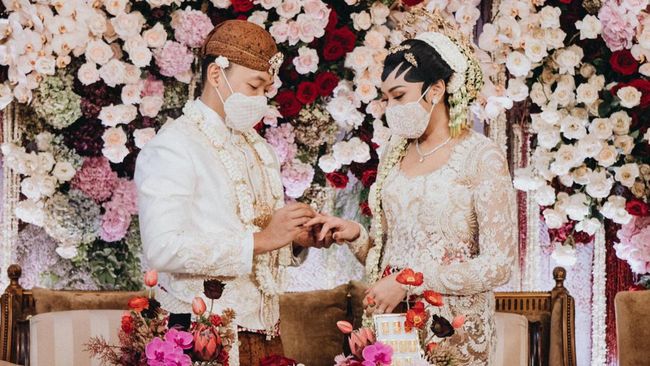Javanese traditional wedding has a long but meaningful procession.
Although many couples choose to marry in a modern way, in fact not a few couples decide to marry according to Javanese custom with the blessing of both parents.
For some people, it may be familiar with Javanese traditional wedding ceremonies which are known to be sacred because they involve many rituals and taboos. However, there are also those who still feel lay or do not understand the sequence of the process.
Well, for those of you who are planning to get married in the near future or want to know more about the Javanese traditional wedding procession, this article can be a reference for you. Let's take a closer look!
Javanese Traditional Wedding Procession
Javanese traditional wedding rituals are divided into several stages. If traced from beginning to end, there are at least 17 stages that need to be passed.
1. Installation of Tarub, Tawuhan, and Bleketepe
In Javanese traditional marriage, there is a ritual performed as a marker of marriage. Namely by installing Tarub, Tawuhan, and Bleketepe.
According to tradition, the installation of a tarub is interpreted as a shade of a house or roof that is able to shade anyone who is under it. In addition, the installation of Tarub is also always decorated with curved yellow leaves.
Next is the installation of bleketepe. Namely a wicker made of coconut and used as a wedding decoration.
Finally, the installation of tawuhan on the left and right sides of the entrance gate. Tawuhan itself is a fruit and plant. Generally, the tawuhan used is in the form of young coconuts, plantains, coconut leaves, and a bunch of rice.
Both bleketepe and tawuhan, have good expectations. Namely as a symbol of the existence of a wedding and a family that celebrates hoping for blessings and prosperity for the bride and groom.
2. Sungkeman To Parents
Sungkeman is not only performed at Javanese traditional weddings. Sungkeman is also performed at other traditional weddings.
The purpose of the sungkeman itself is a request for prayer and blessing from the parents of the bride and groom to carry out the wedding, gratitude for caring for them from childhood to adulthood, and a form of apology for any mistakes that have been made.
3. Siraman
The siraman procession is carried out by the parents, namely the father and mother of the bride and groom as a form of self-purification before undergoing a sacred ceremony.
Siraman can not only be done by parents but also by married relatives to be asked for their blessings. Not only that, the watering process is carried out in odd numbers, between 7 and 9 people.

Image Source: Instagram/maudyayunda
4. Paes or Ngerik
Next, after the bride's hair is drenched, the makeup will take part by drying the hair in a hundred ways. This is done so that the bride's hair always smells good until the wedding day.
After that, the make-up will begin to scrape the fine hair that is on the forehead. The goal is to get rid of bad luck and bad things that have happened to the prospective bride. Only after that, the make-up will make a pattern of cengkorong paes.
In the process of paes or creaking, the makeup artist is usually required to fast first.
5. Adol Dawet
The next step of Javanese traditional marriage is adol dawet. In the form of an event selling dawet held by the parents of the bride and groom which will later be sold to guests who attend the ritual.
Although selling, in fact, at this event there are not really buying and selling transactions, the giving of dawet which is then exchanged for pottery or kwereng coins made of clay.
This procession contains a philosophy about the necessities of life that come from the earth and as a form of sign that humans will return to the land.
6. Midodareni
The word midodareni in Javanese traditional wedding processions comes from the word widadari which means angel.
Midodareni is performed by the bride from 18.00 - 24.00 by staying in the room in simple light make-up. The bride and groom are also accompanied by their mother and close relatives who are also women.
During the midodareni period, pinisepuh will give advice or advice related to married life.
Then, after the midodareni is finished, the father of the bride will ask about her daughter's determination to marry the man she chooses.
In addition, this process is also side by side with the nyantri procession where the prospective groom accompanied by relatives comes to the bride's house as a sign that he is healthy and can hold the wedding the next day.
7. Srah-Srahan
Sarah-srahan is a stage in Javanese traditional marriage in the form of handing over goods from the groom to the woman. Performed at night when midodareni takes place, this event is represented by the parents of the bride.
8. Panggih Ceremony
The Panggih ceremony is a post-wedding procession or peak event where the bride and groom officially become husband and wife. The Panggih ceremony opened with a crazy dance.
9. Submission of Sanggan
This is followed by the submission of sanggan to the parents of the bride as a symbol of their daughter's redemption.
The sanggan given contains one tangkep or two plantain combs, betel ayu, flower telon consisting of roses, jasmine, as well as lawe thread.
10. Balangan Gantal
Balangan gantal is a ritual that exists in Javanese traditional weddings as a symbol of the bride and groom throwing love at each other.
Objects that are thrown in the form of betel leaves filled with betel nut, gambier, whiting, black tobacco are combined and then tied with lawe thread.
How to throw it is quite unique. First, the groom throws a pillow on the forehead, chest, and knees of the bride. Then the bride responds by throwing pillows at the groom's chest and knees.
11. Wijikan
The wijikan ritual or often referred to as ranupada, is a ritual of washing feet three times by the bride to the groom.
This ritual is carried out as a form of the wife's devotion to her husband, as well as removing all obstacles to a happy household.
12. Kanten Asto
This one procession is the difference between the kawula (ordinary people) and the nobility. If the sultan's daughter is carried out a pondong procession, then for the subjects there is a kanten asto procession.
In this procession, the bride and groom stand side by side, intertwine their little fingers with each other and walk together towards the aisle.
13. Tanem Jero
After arriving at the aisle, the bride and groom stand facing the invited guests with their backs to the aisle chairs.
This procession is witnessed by the father and mother of the bride, after which the father of the bride will pat the shoulders of the bride and groom to seat them on the aisle.
14. Tampa Kaya
Tampa Kaya is a Javanese traditional wedding procession which is often called kacur-kacur. This procession has a meaning so that the bride will be able to manage the living provided by her husband as best as possible.
It is done by pouring the seeds (kaya) on the pandan mat that the bride is holding. The grains consist of soybeans, unhulled rice, peanuts, yellow rice, rice, corn, spices, sritaman flowers, and coins.
15. Dhahar Kalimah
Dhahar kalimah is a traditional Javanese wedding procession that symbolizes the harmony of husband and wife and can bring happiness to the family.
This procession is carried out by the groom making three yellow rice fists which are then placed on a plate held by the bride.
The bride is welcome to enjoy the yellow rice one by one, then the groom will give a glass of water.
16. Ngunjuk Rujak Degan
Something sweet must be felt together. That is the implied meaning of this one responsible wedding procession.
Rujak degan itself is a drink made from shavings of young coconut with a mixture of brown sugar.
This ritual is carried out by the way the bride's father tastes rujak with which the bride's mother feeds her. Then, the father feeds the groom with rujak degan, while the mother feeds the bride.
17. Mapag Besan
The ritual of picking up besan in Javanese traditional weddings is called mapag besan. This ritual is deliberately carried out because the parents of the groom are not allowed to be present during the Panggih procession until the ngunjuk rujak ceremony.
Estimated Cost of Javanese Traditional Wedding
Like weddings in general, Javanese traditional weddings require a budget that you need to prepare in advance.
Reporting from financialku.com, for a simple Javanese traditional wedding it takes at least 13 million. These fees will be used for various things, including:
1. Wedding Makeup and Dress
Javanese traditional wedding make-up and clothing are included for the bride and groom, parents, receptionists, and relatives. No need to borrow wedding clothes separately.
2. Typical Javanese Wedding
The existing budget of 13 million includes the Pergola or Javanese traditional wedding aisle. It includes decorations and flowers.
3. Bridal Room
It's hard to believe, but with this budget, you can get a bridal room that has been neatly arranged for the bride and groom.
4. Event Needs
Javanese traditional wedding needs include 100 chairs, 4 tents, a buffet table, spoons, and forks, as well as 2 reception tables. In addition, the WO also prepared 3 fluorescent lamps with a power of 40 watts, 2 souvenir boxes, 2 guest books, and 2 money boxes.
5. Wedding Photos and Videos
It doesn't feel right if one of the most important moments is not captured properly. Now, with the 13 million Javanese traditional wedding budget, the WO also provides video shooting and digital photos.
Keep in mind, the budget of 13 million is just a rough estimate. To find out in detail how much budget needs to be provided, you can do research online or ask the wedding organizer (WO).
Well, for BFI friends who need quick funds to disburse for wedding expenses with an easy process without being complicated, you can apply for it at BFI Finance!
BFI Finance is a finance company that has been verified by the OJK (Financial Services Authority). By borrowing through BFI Finance, you will get various benefits such as the following.
Disbursement of funds up to 85% of the value of the vehicle and a tenor of up to 3 years.
Loan funds with a fast process and a maximum tenor of up to 18 months.
Low interest starts from 0.9% with a long tenor of up to 48 months.
This is information related to Getting to Know Javanese Traditional Weddings and Estimated Costs Required. Hopefully, this article can provide the information you are looking for and be useful for the future.
Keep up with our articles on business, lifestyle, general information, and so on on the BFI Blog. Update every Monday-Friday







